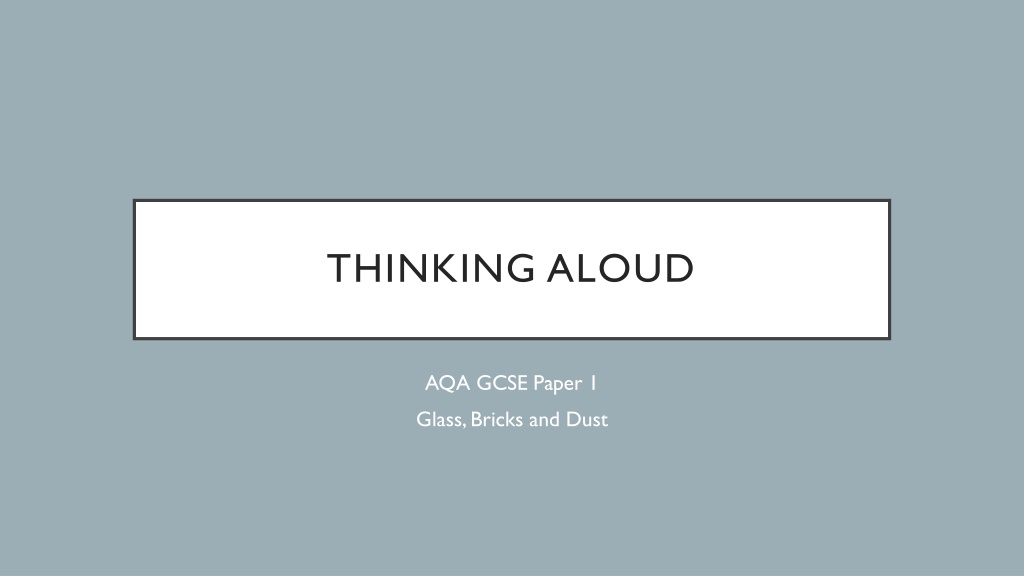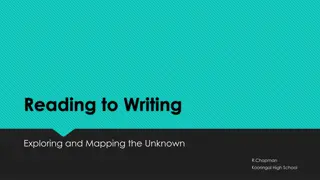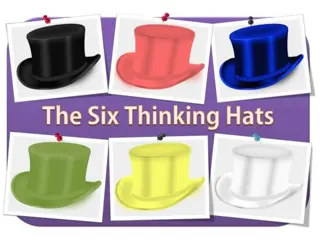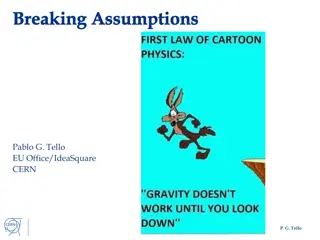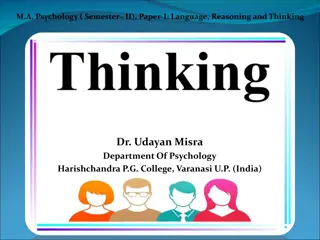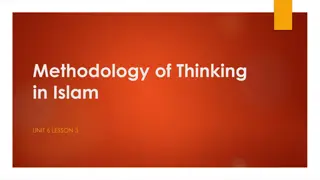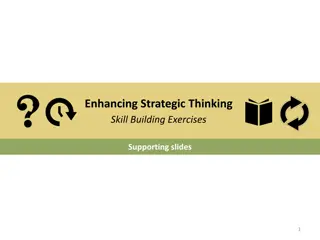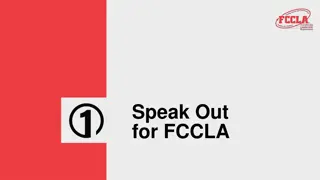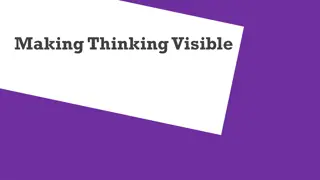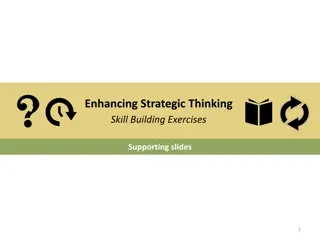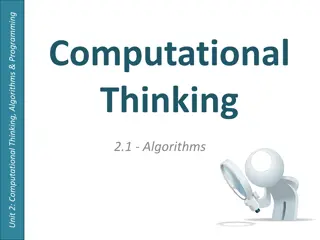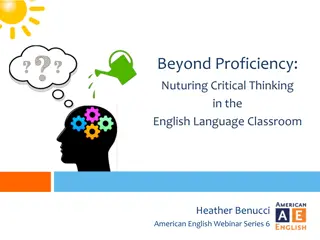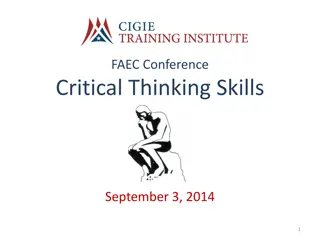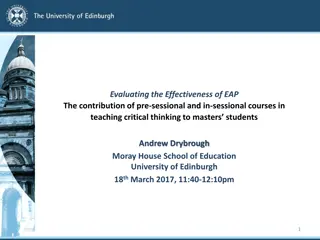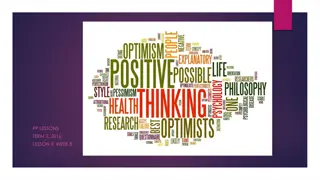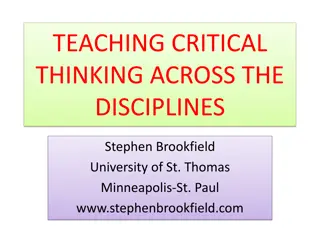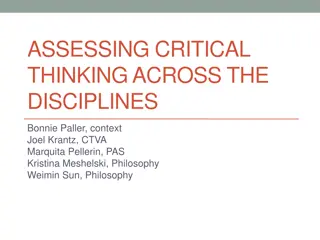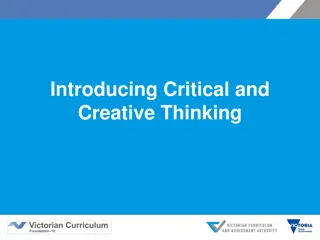THINKING ALOUD
Delve into the intriguing topics of glass, bricks, and dust as part of your GCSE Paper 1 preparation. Explore the properties and applications of these materials, understanding their significance in various fields. Gain insights into their composition and characteristics, enhancing your knowledge and analytical skills for the exam. Prepare thoroughly with this comprehensive resource focusing on essential concepts related to glass, bricks, and dust.
Download Presentation

Please find below an Image/Link to download the presentation.
The content on the website is provided AS IS for your information and personal use only. It may not be sold, licensed, or shared on other websites without obtaining consent from the author.If you encounter any issues during the download, it is possible that the publisher has removed the file from their server.
You are allowed to download the files provided on this website for personal or commercial use, subject to the condition that they are used lawfully. All files are the property of their respective owners.
The content on the website is provided AS IS for your information and personal use only. It may not be sold, licensed, or shared on other websites without obtaining consent from the author.
E N D
Presentation Transcript
THINKING ALOUD AQA GCSE Paper 1 Glass, Bricks and Dust
QUESTION 1 Read again the first part of the Source from lines 1 to 7. List four things from this part of the Source about the boy. [4 marks]
Question 1 Identify four things This question should take 5 minutes 1) Identify the topic focus 2) Read the section of text 3) Write out your answers, using the topic focus Example: Q: Identify four things about the boy 1. The boy is 2. The boy is 3. The boy is 4. The boy is
QUESTION 2 Look in detail at this extract from lines 5 to 15 of the Source: How does the writer use language here to describe the boy playing in the evening? You could include the writer s choice of: words and phrases language features and techniques 1 Simple comment on effects sentence forms. [8 marks] 2 Comments on effects 3 Clear explanation of effects 4 Analysis of effects
Key methods to look for: Emotive language Descriptive language Sensory imagery Dialogue Metaphor, simile or personification Repetition Question 2 Analyse Language This question should take 10 minutes 1) Identify and underline the topic focus of the question 2) Highlight at least three short quotes for your evidence. 3) Identify the methods or language techniques the writer is using. 4) Write up your response, commenting on how the methods used present the topic focus. Zoom in on: Adjective Verb Phrase Adverb 1 Simple comment on effects Explaining the effects of language: This shows how This connotes This suggests to the reader In particular, the verb shows how This creates the impression that 2 Comments on effects 3 Clear explanation of effects 4 Analysis of effects
QUESTION 3 You now need to think about the whole of the Source. This text is from the middle of a short story. How has the writer structured the text to interest you as a reader? You could write about: what the writer focuses your attention on at the beginning how and why the writer changes this focus as the Source develops any other structural features that interest you. [8 marks] 1 Simple comment on effects 2 Comments on effects 3 Clear explanation of effects 4 Analysis of effects
Question 2 Analyse Structure Key verbs for explaining writer s use of structure: Guides Builds Creates tension Climaxes Establishes Resolves Links Suggests/hints Introduces Key words to describe a readers response: Curiosity Excitement Concern Suspicion Dread Surprise Satisfaction Sympathy Realisation This question should take 10 minutes It will ask how the text is structured to interest the reader. The key word in this question is interest . Ask yourself in this extract, what is keeping the reader interested? 1. 2. Number off the paragraphs. Re-read the extract and identify the changes in focus in the margin. Identify which changes in focus help to interest the reader. Write up your response, explaining how the writer has guides the reader to keep them interested. 1 Simple comment on effects 2 Comments on effects 3. 3 Clear explanation of effects 4. 4 Analysis of effects
QUESTION 4 Focus this part of your answer on the second part of the Source from line 16 to the end. A reviewer wrote: This end part of the extract where the boy s game comes to life takes a darker and more chilling tone. To what extent do you agree? In your response, you could: consider your own impressions of the boy s game evaluate how the writer creates a dark and chilling tone support your response with references to the text. 1 Simple evaluation of effect No understanding of methods 2 Some evaluation of effects Some understanding of methods [20 marks] Clear evaluation of effects Clear understanding of methods 3 4 Detailed and critical evaluation of effects Perceptive understanding of methods
Common Methods: Perspective (1st, 2nd or 3rd person?) Tone Dialogue to present characters Figurative language (metaphor, simile or personification) Sensory Language (imagery) Descriptive Language Repetition Word choice (adjective, verb, adverb, noun) Different sentence types and forms Structure Question 4 Evaluate This question should take 25 minutes. It will ask how far you agree with a statement about the extract. 1) Check the statement carefully and underline key words 2) Re-read the text, highlighting any evidence that links to the claim. 3) Decide how the writer has presented the subject to you (the methods they have used). 4) Number off your best evidence 1-5. 5) Write up your response, using your best evidence first. 6) Remember to explain whether you agree with the statement. Simple evaluation of effect No understanding of methods 1 Some evaluation of effects Some understanding of methods 2 Tips: The claim is usually true to some extent but how far do you agree? Stay focused on the statement by using the key words in your answer. Embed your quotes to help use a range of evidence. Clear evaluation of effects Clear understanding of methods 3 Detailed and critical evaluation of effects Perceptive understanding of methods 4
QUESTION 5 You have been invited to produce a piece of creative writing about how children play imaginatively. Either: Write a story set on a dark night as suggested by this picture: Or: Write a story about a game that goes badly wrong. 24 marks for content and organisation 16 marks for technical accuracy [40 marks]
